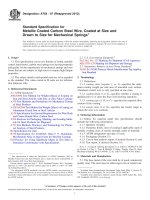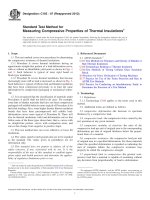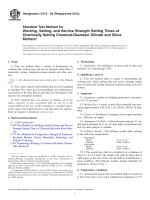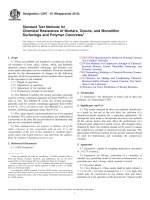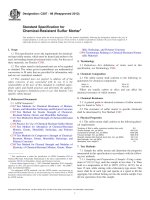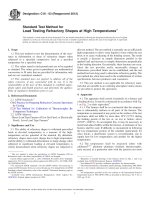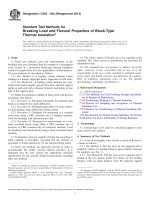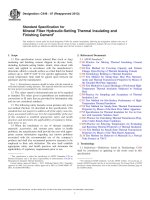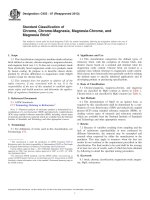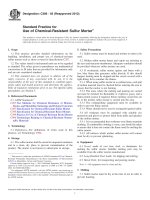Astm c 1130 07 (2012)
Bạn đang xem bản rút gọn của tài liệu. Xem và tải ngay bản đầy đủ của tài liệu tại đây (254.99 KB, 8 trang )
Designation: C1130 − 07 (Reapproved 2012)
Standard Practice for
Calibrating Thin Heat Flux Transducers1
This standard is issued under the fixed designation C1130; the number immediately following the designation indicates the year of
original adoption or, in the case of revision, the year of last revision. A number in parentheses indicates the year of last reapproval. A
superscript epsilon (´) indicates an editorial change since the last revision or reapproval.
the Guarded-Hot-Plate Apparatus
C518 Test Method for Steady-State Thermal Transmission
Properties by Means of the Heat Flow Meter Apparatus
C1041 Practice for In-Situ Measurements of Heat Flux in
Industrial Thermal Insulation Using Heat Flux Transducers
C1044 Practice for Using a Guarded-Hot-Plate Apparatus or
Thin-Heater Apparatus in the Single-Sided Mode
C1046 Practice for In-Situ Measurement of Heat Flux and
Temperature on Building Envelope Components
C1114 Test Method for Steady-State Thermal Transmission
Properties by Means of the Thin-Heater Apparatus
C1155 Practice for Determining Thermal Resistance of
Building Envelope Components from the In-Situ Data
C1363 Test Method for Thermal Performance of Building
Materials and Envelope Assemblies by Means of a Hot
Box Apparatus
1. Scope
1.1 This practice, in conjunction with Test Method C177,
C518, C1114, or C1363, establishes an experimental procedure
for determining the sensitivity of heat flux transducers that are
relatively thin.
1.1.1 For the purpose of this standard, the thickness of the
heat flux transducer shall be less than 30 % of the narrowest
planar dimension of the heat flux transducer.
1.2 This practice discusses a method for determining the
sensitivity of a heat flux transducer to one-dimensional heat
flow normal to the surface and for determining the sensitivity
of a heat flux transducer for an installed application.
1.3 This practice should be used in conjunction with Practice C1046 when performing in-situ measurements of heat flux
on opaque building components.
1.4 This practice is not intended to determine the sensitivity
of heat flux transducers that are components of heat flow meter
apparatus, as in Test Method C518.
3. Terminology
3.1 Definitions—For definitions of terms relating to thermal
insulating materials, see Terminology C168.
1.5 This practice is not intended to determine the sensitivity
of heat flux transducers used for in-situ industrial applications
that are covered in Practice C1041.
1.6 This standard does not purport to address all of the
safety concerns, if any, associated with its use. It is the
responsibility of the user of this standard to establish appropriate safety and health practices and determine the applicability of regulatory limitations prior to use.
3.2 Definitions of Terms Specific to This Standard:
3.2.1 mask—material (or materials) having the same, or
nearly the same, thermal properties and thickness surrounding
the heat flux transducer thereby promoting one-dimensional
heat flow through the heat flux transducer.
3.2.2 sensitivity—the ratio of the electrical output of the heat
flux transducer to the heat flux passing through the device
when measured under steady-state heat flow.
3.2.3 test stack—a layer or a series of layers of material put
together to comprise a test sample (for example, a roof system
containing a membrane, an insulation, and a roof deck).
2. Referenced Documents
2.1 ASTM Standards:2
C168 Terminology Relating to Thermal Insulation
C177 Test Method for Steady-State Heat Flux Measurements and Thermal Transmission Properties by Means of
3.3 Symbols: R = thermal resistance, m2·K/W (h·ft2·F /Btu)
q = heat flux, W/m2 (Btu ⁄h·ft2)
flux
expected
in
application,
Q expected = heat
W/m2 (Btu ⁄h·ft2)
E = measured output voltage, V
S = sensitivity, V/(W/m2) (V ⁄(Btu ⁄hr·ft2))
∆T = temperature difference, K (°F)
Rlayer = thermal resistance of a layer in the test stack,
m2·K/W (h·ft2·F /Btu)
T = temperature, K (°F)
uc = combined standard uncertainty
1
This practice is under the jurisdiction of ASTM Committee C16 on Thermal
Insulation and is the direct responsibility of Subcommittee C16.30 on Thermal
Measurement.
Current edition approved Sept. 1, 2012. Published November 2012. Originally
approved in 1989. Last previous edition approved in 2007 as C1130 – 07. DOI:
10.1520/C1130-07R12.
2
For referenced ASTM standards, visit the ASTM website, www.astm.org, or
contact ASTM Customer Service at For Annual Book of ASTM
Standards volume information, refer to the standard’s Document Summary page on
the ASTM website.
Copyright © ASTM International, 100 Barr Harbor Drive, PO Box C700, West Conshohocken, PA 19428-2959. United States
1
C1130 − 07 (2012)
5.1.2 When bringing the heat flux transducer voltage leads
out of the test instrument, take care to avoid air gaps in the
mask or between the sample stack and the test instrument. Fill
air gaps with a conformable material, such as toothpaste, caulk,
or putty, or cover with tape.
u1 = standard uncertainty of the regression coefficients
u2 = standard uncertainty for replicate measurements
u3 = standard uncertainty for the measurement
ε = error term
4. Significance and Use
NOTE 3—The heat flux transducers do not need to be physically adhered
to the mask or embedding material but should fit well enough to assure
good thermal contact. If needed, apply thermally conductive gel to one or
both faces of the heat flux transducer to improve the thermal contact.
Material compatibility must be considered in the selection of any such gel.
4.1 The use of heat flux transducers on building envelope
components provides the user with a means for performing
in-situ heat flux measurements. Accurate translation of the heat
flux transducer output requires a complete understanding of the
factors affecting its output, and a standardized method for
determining the heat flux transducer sensitivity for the application of interest.
5.1.3 Place a temperature sensor on or near the heat flux
transducer. Connect temperature sensor(s) applied to the heat
flux transducer to a readout device.
5.1.4 When compressible insulation is included in the test
stack, manually control the distance between the hot and cold
apparatus surfaces.
5.1.5 The heat flux transducer(s) must be located within the
metered area of the apparatus. In a hot box apparatus, mount
the heat flux transducers in the central portion of the metered
area of the test panel.
4.2 The sensitivity of the heat flux transducer is determined
primarily by the sensor construction and temperature of operation and the details of the application, including geometry,
material characteristics, and environmental factors.
NOTE 1—Practice C1046 includes an excellent description of heat flux
transducer construction.
4.3 The presence of a heat flux transducer is likely to alter
the heat flux that is being measured. To determine the heat flow
that would occur in the absence of the transducer, it is
necessary to either:
4.3.1 Ensure that the installation is adequately guarded (1).3
4.3.2 Adjust the results based on a detailed model or
numerical analysis. Such analysis is beyond the scope of this
practice, but details can be found in (2-6).
4.3.3 Use the empirically measured heat flux transducer
sensitivity measured under conditions that adequately simulate
the conditions of use in the final application.
5.2 Three separate test stack preparations are discussed to
determine appropriately: the one-dimensional sensitivity, the
sensitivity for embedded configurations, and the sensitivity for
surface-mounted configurations.
5.3 One-Dimensional Sensitivity—The heat flux transducer
shall be embedded in a test stack and surrounded with a mask,
as shown in Fig. 1.
5.3.1 The test stack shall consist of a sandwich of the heat
flux transducer/masking layer between two layers of a compressible homogeneous material, such as high-density fibrous
glass insulation board, to assure good thermal contact between
the plates of the tester and the heat flux transducer/masking
layer.
5.3.2 The mask must have the same thickness and thermal
resistance as the heat flux transducer.
5.3.3 The mask or embedding material should be significantly larger than the metering area of the test equipment and
ideally be the same size as the plates of the apparatus.
5.3.4 To measure the sensitivity of multiple small heat flux
transducers, the heat flux transducer/mask layer shown in Fig.
1 is replaced with a layer containing an arrangement of
transducers located within the metered area of the apparatus as
illustrated in Fig. 2.
4.4 There are several methods for determining the sensitivity of heat flux transducers, including Test Methods C177,
C518, C1114, and C1363. The selection of the appropriate
procedure will depend on the required accuracy and the
physical limitations of available equipment.
4.5 This practice describes techniques to establish uniform
heat flow normal to the heat flux transducer for the determination of the heat flux transducer sensitivity.
4.6 The method of heat flux transducer application must be
adequately simulated or duplicated when experimentally determining the heat flux transducer sensitivity. The two most
widely used application techniques are to surface-mount the
heat flux transducer or to embed the heat flux transducer in the
insulation system.
5.4 Sensitivity, Embedded Configuration—Place the heat
flux transducer, in a fashion identical to its end use application,
in a test stack duplicating the building construction to be
evaluated. An example of a test stack, for the case where the
heat flux transducer is to be embedded in gypsum wallboard
facing an insulated wall cavity, is shown in Fig. 3.
NOTE 2—The difference between the sensitivity under uniform normal
heat flow versus that for the surface-mounted or embedded configurations
has been demonstrated using multiple mathematical techniques (7-9).
5. Specimen Preparation
5.1 Specimen Preparation for All Cases:
5.1.1 Check the electrical continuity of the heat flux transducer. Connect the heat flux transducer voltage leads to the
auxiliary measurement equipment (for example, voltmeter)
having a resolution of 6 2 µV or better.
5.5 Sensitivity, Surface-Mounted Configuration—Apply the
heat flux transducer in a manner identical to that of actual use
as specified in Practice C1046. Important considerations for
surface mounting include thermal contact between the heat flux
transducer and the surface and matching of the emittance of the
heat flux transducer and test construction. An example of a test
arrangement, for the case where the heat flux transducer is to
be surface-mounted, is shown in Fig. 4.
3
The boldface numbers in parentheses refer to the references at the end of this
standard.
2
C1130 − 07 (2012)
FIG. 1 Example of a Test Stack Used to Measure Heat Flux Transducer Sensitivity, Side View
NOTE 1—Some apparatus metering areas are round.
FIG. 2 Top View of the Heat Flux Transducer/Mask Layer Within the Test Stack for the Case Where Multiple Small Heat Flux Transducers are Evaluated Simultaneously
NOTE 4—In many cases, several surface-mounted heat flux transducers
will be used at one time and can be analyzed for sensitivity simultaneously.
the heat flux through the heat flux transducer. Apparatuses that
typically require two samples should be operated in the
single-sided mode in conformance with Practice C1044.
6. Procedure
6.2 Vary the hot- and cold-surface plates of the test instrument to produce the range of heat fluxes and mean temperatures according to the guidance found in Appendix X1 and
Appendix X2.
6.1 Use a guarded-hot-plate, heat flow meter, hot box, or
thin-heater apparatus. Follow Test Method C177, C518,
C1363, or C1114, including test stack conditioning, to measure
3
C1130 − 07 (2012)
FIG. 3 Example of Test Stack Emulating an Embedded Position Within an Insulated Wall Cavity, Side View
NOTE 1—Drawing not to scale, heat flux transducer size exaggerated relative to hot box dimensions.
FIG. 4 Example of a Test Stack for a Surface-Mounted Heat Flux Transducer
4
C1130 − 07 (2012)
8.1.3 The test stack composition, including the location of
the heat flux transducer, the material used to mask or embed the
heat flux transducer, and any additional layers of material used
in the assembly.
6.2.1 For surface-mounted heat flux transducers tested using
Test Method C1363, also control the convection and radiation
conditions to match the expected application.
6.3 Care shall be taken to perform these tests at heat fluxes
that are large enough to limit errors due to the readout
electronics and that are similar to the anticipated levels of heat
flux in the end-use experiment.
NOTE 7—A diagram of the test stack is suggested.
8.1.4 The temperatures of the heat flux transducer and
surface plates.
8.1.5 The heat flux transducer sensitivity and/or calibration
factor. When multiple data points are available, provide correlations and R2 values.
8.1.6 If known, provide the apparatus clamping pressure.
6.4 Ensure that the test stack has reached a steady state
condition before taking data, including the voltage output from
the heat flux transducer leads. This may require a longer
settling time than is typical for these test methods.
9. Precision and Bias
9.1 Precision data from one laboratory using Test Method
C177 are given in Table 1 for two sizes of heat flux transducers
having coplanar copper-constantan thermoelectric junctions in
a glass-fiber reinforced epoxy substrate. The repeatability
standard deviations were determined by pooling replicate data
and weighting with their respective degrees of freedoms (10).
9.2 Bias—No information can be presented on the bias of
the procedure in Practice C1130 for calibrating thin heat flux
transducers because no transducer having an accepted reference value is available.
9.3 After the heat flux transducers are calibrated, they are
used to measure heat flux in a building assembly. The heat flux
measured by two different types of independently calibrated
HFTs installed at the same time in the same roof assembly
measured a difference in heat flux of approximately 8 % (11).
NOTE 5—Theoretically, the output of the heat flux transducer is zero
when there is no heat flux through the transducer. Eq 1 and 2 are based
upon this assumption. For a more rigorous check of heat flux transducer
response, the user is referred to Appendix X1 which requires that the user
flip the heat flux transducer over and repeat the test at the same
temperature conditions. A simpler approach that has been used to check
this assumption is to enclose the heat flux transducer within heavy
insulation and place the heat flux transducer and insulation within a
temperature-stable environment for 24 h before checking that the output
voltage is indeed zero under conditions of no heat flux.
7. Calculation
7.1 For a single-point calibration, use the measured heat
flux, q, and voltage, E to calculate the sensitivity, depending
upon the test stack chosen, as shown in Eq 1.
S5
E
q
(1)
7.2 When multiple data points are available, evaluate the
data using the selected model as discussed in Appendix X1.
10. Measurement Uncertainty
10.1 Evaluate the uncertainty for the calibration results
using current international guidelines (12). Determine the
combined standard uncertainty using Eq 3.
7.3 An example of a least square linear fit of sensitivity as
a function of temperature is shown in Fig. 5. Alternative
models and data analysis are discussed in Appendix X1.
u c 5 =u 21 1u 22 1u 23
NOTE 6—Do not confuse calibration terminology in this practice with
that in other C16 application standards. For example, Practice C1046 uses
the term “conversion factor” (which also is designated S and has units of
(W/m2) per V) to relate the measured HFT output to the flux through the
building envelope. This practice advocates using the following form (Eq
2) for applications of heat flux transducers:
q5
E
S
(3)
10.2 The measurement uncertainty includes the standard
uncertainty of the test method used for calibration and the
standard uncertainty of any auxiliary measurement equipment,
for example, the voltmeter used to measure the DC output
signal of the heat flux transducer(s).
10.3 The uncertainty of the heat flux and the HFT output
must be determined along with the departure from unidirectional heat flow when the masking technique is employed. The
magnitude of this effect can be determined by performing a
series of experiments with masks of varying thermal resistances.
(2)
8. Report
8.1 Report the following information:
8.1.1 The heat flux transducer manufacturer, model
identification, size, thickness, geometry (that is, square or
round), and dimensions.
8.1.2 The ASTM Test Method used and the size of the
apparatus plates.
11. Keywords
11.1 calibration; heat flux transducer; in situ testing;
sensitivity
5
C1130 − 07 (2012)
FIG. 5 An Example of Data Analysis for Sensitivity Measured as a Linear Function of Temperature, Least Squares Linear Fits Shown
6
C1130 − 07 (2012)
TABLE 1 Repeatability Standard Deviations for a Heat Flux
Transducer (10) Determined Using Test Method C177
Size
500 mm × 500 mm
610 mm × 610 mm
Meter Area
Nominal Thickness
S
Standard deviation
Number of Specimens
250 mm ì 250 mm
0.8 mm
94.0 àV/(WÃm2)
0.53 àV/(WÃm2)
9
305 mm ì 305 mm
0.8 mm
136.4 µV/(W·m2)
0.40 µV/(W·m2)
3
APPENDIXES
(Nonmandatory Information)
X1. DATA ANALYSIS MODELS
X1.1 A simple linear model, with the heat flux sensitivity
shown as a simple function of temperature, is often used.
ing HFTs (see Eq X1.1) (10). For that study, the design of
experiment randomly varied both variables—heat flux (q) and
temperature (T) to provide the data needed to evaluate that
model. Note that in the final analysis of the HFT calibration
data, the temperature effect over the range of 10 to 50°C was
essentially negligible for the type of heat flux transducers
studied (10).
X1.2 Other models are possible and may be needed for
certain transducers in certain environments. For example, over
a large temperature range, it is likely that a non-linear equation
may be necessary to fit the data.
X1.3 Base the design of experiment upon the data requirements of the selected model.
X1.3.1 For a linear model, it is customary to vary one
variable at a time, for example first heat flux and then
temperature.
X1.3.2 As noted in Zarr et al, a model linear in heat flux and
temperature with an interaction term was assumed for calibrat-
E 5 a 0 1a 1 q1a 2 T1a 3 qT1ε
(X1.1)
X1.4 Whichever model is used, the R2 statistic can be useful
for evaluating the “goodness of fit.” However, it is also a good
idea to examine the residuals of the fit to check underlying
assumptions in the calibration data.
X2. GUIDANCE FOR DETERMINING TEST BOUNDARY TEMPERATURES
full application construction, calculate the hot and cold-side
temperatures. For the case where the test stack includes the
material facing the cold boundary condition, use Eq X2.4 and
X2.5. For the case where the test stack includes the material
facing the hot boundary condition, use Eq X2.4 and Eq X2.6.
X2.1 If the Desired Heat Flux and Transducer Temperature
are Known—Using nominal values for the thermal
resistance of each material in the test stack, calculate the
required temperature difference to achieve the desired heat flux
using Eq X2.1 and the hot and cold-side temperatures using Eq
X2.2 and X2.3.
∆T 5 Q expected 3
(
Test Stack
S
T cold 5 T transducer 2 Q expected 3
T hot 5 T cold1∆T
R layer
transducer
(
cold plate
Q expected 5
(X2.1)
R layer
D
T boundary hot 2 T boundary cold
(
Full Construction
(X2.2)
~ where (
Full Construction
(X2.3)
R layer includes the surface resistance
~
2 ~Q
T hot 5 T boundary cold1 Q expected 3
X2.2 If Boundary Conditions for the Application are
Known—Using nominal values for the thermal resistance of each material in the test stack and each material in the
T cold 5 T boundary hot
7
(X2.4)
R layer
expected
(
(
Test Stack
3
R layer
Test Stack
!
!
R layer
!
(X2.5)
(X2.6)
C1130 − 07 (2012)
REFERENCES
(1) Burch, D. M., and Zarr, R. R., “An Evaluation of the Heat Flux
Transducer Technique for Measuring the Thermal Performance of
Walls,” Special Report 91-3, In-Situ Heat Flux Measurements in
Buildings—Applications and Interpretations of Results, U.S. Army
Cold Regions Research and Engineering Laboratory, Stephen N.
Flanders, Editor, February 1991.
(2) Trethowen, H. A., “Engineering Applications of Heat Flux Sensors in
Buildings—The Sensor and Its Behavior,” Building Applications of
Heat Flux Transducers, ASTM STP 885, Edited by E. Bales, M.
Bomberg, and G. E. Courville, ASTM, 1985.
(3) van der Graaf, F., “Research in Calibration and Application Errors of
Heat Flux Sensors,” Building Applications of Heat Flux Transducers,
ASTM STP 885, Edited by E. Bales, M. Bomberg, and G. E. Courville,
ASTM, 1985.
(4) Baba, T., Ono, A., and Hattori, S., “Analysis of the Operational Error
of Heat Flux Transducers Placed on Wall Surfaces,” Review of
Scientific Instruments, 56 (7), July 1985.
(5) Apthorp, D. M., and Bligh, T. P., “Modelling of Heat Flux Distortion
Around Heat Flux Sensors,” Building Applications of Heat Flux
Transducers, ASTM STP 885, Edited by E. Bales, M. Bomberg, and G.
E. Courville, ASTM, 1985.
(6) Schwerdtfeger, P., “The Measurement of Heat Flow in the Ground and
the Theory of Heat Flux Meters,” Technical Report 232, U.S. Army
Cold Regions Research and Engineering Laboratory, Hanover, NH,
1970.
(7) Bligh, T. P., and Apthorp, D. M., “Heat Flux Sensor Calibration
Technique,” Building Applications of Heat Flux Transducers, ASTM
STP 885, Edited by E. Bales, M. Bomberg, and G. E. Courville,
ASTM, 1985.
(8) Orlandi, R. D., Derderian, G. D., Shu, L. S., and Siadat, B.,
“Calibration of Heat Flux Transducers,” Building Applications of
Heat Flux Transducers, ASTM STP 885, Edited by E. Bales, M.
Bomberg, and G. E. Courville, ASTM, 1985.
(9) Desjarlais, A. O., and Tye, R. P., “Experimental Methods for Determining the Thermal Performance of Cellular Plastic Insulation Materials Used in Roofs,” Presented at the 8th Conference on Roofing
Technology, Gaithersburg, MD, 1987.
(10) Zarr, R. R., Martinez-Fuentes, V., Filliben, J. J., and Dougherty, B.
P., “Calibration of Thin Heat Flux Sensors for Building Applications
Using ASTM C1130,” JTEVA, Vol 29, No. 3, May 2001, pp.
293-300.
(11) Courville, G. E., Desjarlais, A. O., Tye, R. P., and McIntyre, C. R.,
“A Comparison of Two Independent Techniques for the Determination of In-Situ Thermal Performance,” ASTM STP 1030, Edited by D.
McElroy and J. Kimpflen, ASTM, 1990.
(12) ANSI, “U.S. Guide to the Expression of Uncertainty in
Measurement,”ANSI/NCSL Z540-2-1997, 1997.
ASTM International takes no position respecting the validity of any patent rights asserted in connection with any item mentioned
in this standard. Users of this standard are expressly advised that determination of the validity of any such patent rights, and the risk
of infringement of such rights, are entirely their own responsibility.
This standard is subject to revision at any time by the responsible technical committee and must be reviewed every five years and
if not revised, either reapproved or withdrawn. Your comments are invited either for revision of this standard or for additional standards
and should be addressed to ASTM International Headquarters. Your comments will receive careful consideration at a meeting of the
responsible technical committee, which you may attend. If you feel that your comments have not received a fair hearing you should
make your views known to the ASTM Committee on Standards, at the address shown below.
This standard is copyrighted by ASTM International, 100 Barr Harbor Drive, PO Box C700, West Conshohocken, PA 19428-2959,
United States. Individual reprints (single or multiple copies) of this standard may be obtained by contacting ASTM at the above
address or at 610-832-9585 (phone), 610-832-9555 (fax), or (e-mail); or through the ASTM website
(www.astm.org). Permission rights to photocopy the standard may also be secured from the Copyright Clearance Center, 222
Rosewood Drive, Danvers, MA 01923, Tel: (978) 646-2600; />
8
